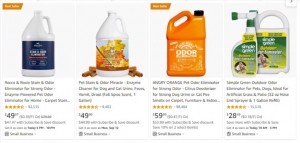Click trickery: How to get your product on page one of Amazon

In a presentation for Vitafoods Insights Europe Virtual Expo earlier this month, Chris Rawlings, founder and CEO of the Amazon PPC (pay per click) management team Sophie Society, outlined fundamental listing errors and key strategies to build brand awareness and boost sales.
Many brands focus on organic ranking and text heavy content to drive volume when outstanding product experience and eye-catching, interactive imagery would deliver much better returns, he explains.
“Amazon is a reputation-based platform that consumers trust; you’d be shocked by how many companies skip actual product experience and go straight to hacks. Up to 60 or 70% of companies that come to us have not nailed this and are bound for failure.”
Furthermore, listings need to adapt to viewing trends. For example, no-one reads words anymore on Amazon, unless they are superimposed on imagery, he says.
"The visuals on the listing are more important than the text... You have to figure out a way to communicate every idea, every concept, every story, every element of your features, benefits, unique selling proposition and customer avatar via a visual communication style, whether that's a video, an infographic, an icon or a photograph, everything has to be communicated visually because no-one reads words on Amazon dot com. If you are fiddling around with what it says in the bullet points you are wasting your time.”
He also noted that most search traffic on Amazon is derived from mobile devices (around 80%) so it's important to make sure the listing looks good on that device first and foremost, then check to make sure it looks good on desktop too.
Brand story modules
The 'story module' section of the listing provides the seller the opportunity to use right swipe 'image cards' with up to 17 pages of images and information that the customer can swipe through. Rawlings says these are a simple but powerful tool to communicate the brand story and set the brand apart from 'faceless' brands with no personality.
"This is insanely powerful - we see huge jumps in conversion when people use the brand story module.
“Most brands don’t have this yet because they don’t know it exists or they don’t know how to use it. We have seen huge jumps in conversion with this module. This is how you are able to charge higher prices without losing conversions,” he comments.
Click tricks
Thumbnail brand imagery is the linchpin to increased click-through rates that translate into traffic and conversions.
These are split-second emotional decisions controlled by the amygdala region of the brain which is naturally drawn to bold imagery, such as
bright colours and large fonts, according to Rawlings.
But this region of the brain is easy to trick.
He cites the Angry Orange pet-odour elimination spray which generated a 20-fold increase in brand value by changing its branding with the amygdala in mind.
They made their product bright orange, with a big eye-catching word 'odor' written on the packaging, to stand out from the crowd and encourage click-through.
“They tricked thumbs not brains – they’re tricking the human nervous system. It’s worth tens of millions if you get it right.”
Know your customer avatar
Rawlings says the 'customer avatar’ should be “all over” listings as well. This simply means that the listing must have the customer front-of-mind whether it be through the imagery (demographics of people photographed), the font (childish or smart), or the wording itself (language which speaks to the customer).
If the 'customer avatar' isn't always front-of-mind “you’re wasting your time”, says Rawlings.
He said if you aren't certain who that is then the best way to find out is by reading through hundreds or thousands of your own reviews to see who is purchasing and writing about your product.
Badges
There are a plethora of different badges available to add to Amazon listings, including the small business badge (for those making under a certain amount a year), climate pledge friendly (third party environmental requirements), best seller (gained by being the best seller in your category), Amazon's choice (gained through people searching through Alexa).
"When you combine all these your mobile listing thumbnail isn't just brighter and more eye-catching but it is also bigger to make room for all the badges," Rawlings explains.
Pay per click
It's important to choose keywords with both high volume and the high relevance.
Rawlings recommends choosing five mid-tail (2-4 words) keywords in the sponsored product campaign option, before moving on to main (1-2 words) and long-tail keywords (2-7 words).
External tools like Google ads and email lists are other invaluable tools to drive traffic to Amazon and boost rankings - 20-30% of Amazon shoppers use Google to shop Amazon.
Plus Amazon 'loves' external traffic and they reward it with higher rankings.
And finally, Rawlings explains that 'post purchase follow-up' is integral to repeat business and reviews.
“This is not optional anymore, any brand that wants to do really well needs a tight customer follow-up sequence with any type of incentive - instructional videos or e-books, discounts on future purchases, additional digital products, warranty registration, story hook, quiz, free product.” he says.
“This is how you get your review velocity up, it’s also how you cross-sell other products and keep your customers in your ecosystem, increasing your lifetime value.”
PPC science
Sophie Society helps small to medium e-commerce businesses increase conversion and traffic on Amazon. It has helped launch over 2,000 products on Amazon.com and driven $138m in revenue on the platform. Rawlings also owns a spinal health e-commerce brand, is a nine-figure mentor in Titan Network and an angel brand investor.





